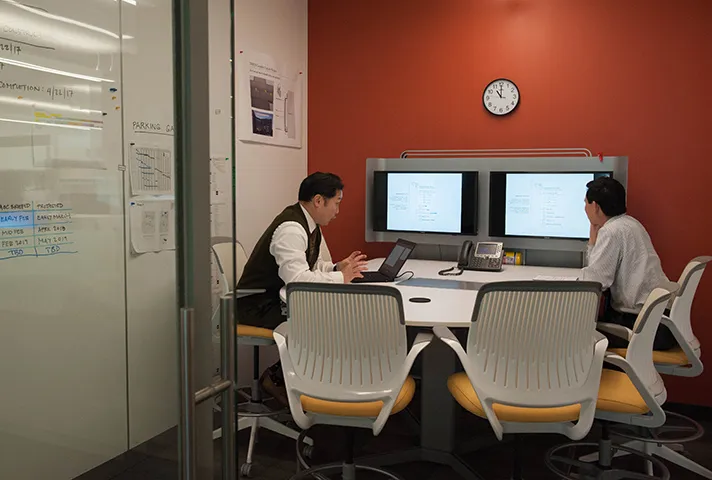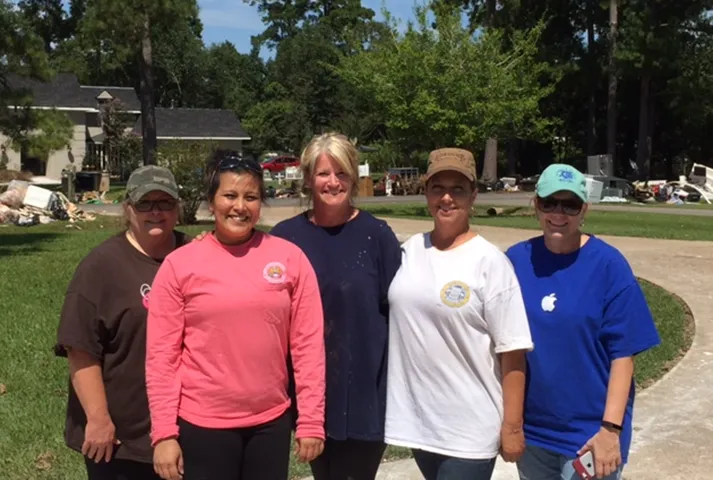Committed to efficiency, safety, and cost containment, the Judiciary has actively reduced the space it occupies in buildings around the country, while also working with the General Services Administration to replace outmoded courthouses with modern, secure facilities.
Space Footprint Reduction
The Judiciary’s space footprint initiative is a multi-pronged effort to contain costs by reducing rent payments and making innovative use of technology to foster efficient use of existing office and courtroom space.
As of October 2017, the Judiciary had achieved a net reduction in its total space footprint of 803,748 square feet. This represents 92.4 percent of the national goal set in 2013 by the Judicial Conference to reduce the Judiciary’s footprint by 3 percent by the end of fiscal year 2018, prorated among the circuits. Projects that were underway in 2017 were expected to yield additional reductions. If all planned projects are completed by the FY 2018 deadline, the 3 percent space reduction target would be surpassed.
Already-completed space reductions have lowered the Judiciary’s annual rent payments by approximately $24.7 million. As an incentive to circuits to reduce space to the greatest extent possible, the Judicial Conference adopted a policy that allows a circuit to “bank” any space released in excess of its prorated space reduction target for use in compliance with the Judiciary’s No Net New policy in fiscal years beyond 2018.
The No Net New policy requires any increase in square footage within a circuit to be offset by an equivalent reduction in square footage in the same fiscal year. While the space footprint reduction policy will expire at the end of FY 2018, the No Net New policy will continue, requiring ongoing vigilance by the courts to manage future space growth. The Conference established as the baseline the square footage of total space holdings within each circuit at the beginning of FY 2013. The policy excludes new courthouse construction, renovation, or alterations projects approved by Congress.
In addition to space reduction and the No Net New policies, the Conference directed each circuit judicial council to formulate a space and rent management plan for achieving space reduction and to explore opportunities to reduce court space by maximizing technology in creating flexibility as to where and when work is performed.
New Courthouse Construction
In 2017, the Administrative Office of the U.S. Courts (AO) continued to help coordinate the planning and construction for eight new courthouses funded by Congress in FY 2016. The AO brings together staff from the courts and from the General Services Administration to review each project’s requirements to make sure that all updated space and security needs are reflected in the project designs. The AO is also working with GSA to ensure that milestones are met and projects remain on track. In the course of 2017, the focus was on collaboration among Judiciary stakeholders. Monthly project meetings of judges, court architects, clerks, and AO staff provided a forum for identifying issues, clarifying policy, and sharing best practices. GSA and the Judiciary are committed to keeping projects on budget and on schedule.
In 2016, Congress provided GSA with approximately $948 million to build courthouses in Nashville, TN; Toledo, OH; Charlotte, NC; Des Moines, IA; Greenville, SC; Anniston, AL; Savannah, GA; and San Antonio, TX. Congress provided partial construction funding for a ninth project in Harrisburg, PA. To ensure that the new courthouses and annexes will be fully operational and in alignment with the Judiciary’s funding responsibilities as outlined in the U.S. Courts Design Guide, the AO is also committed to identifying appropriate funding strategies for items that must be purchased with Judiciary resources, such as IT systems, security, furniture, audio-visual systems, and moving costs.
Judiciary and GSA Agree to Rental Rate Savings
In 2017, the Judiciary and GSA reached consensus on a new rent strategy that allows the Judiciary to pay its obligations based on fair annual rent appraisals rather than on return-on-investment pricing in certain facilities. In a memorandum of agreement, GSA agreed to use the fair annual rent (FAR) appraisal methodology to calculate the rent for the court facilities. With FAR methodology, rent is based on market-based rates and appraisals are done every five years by an outside appraiser and reviewed and approved by GSA. Return-on-investment pricing is used by GSA when the FAR-based rental rates do not meet its return-on-investment target rate, which is a goal set by GSA to ensure its assets are recovering the minimum cost of ownership and reinvestment. The agreement will reduce rents in some cases and also allow courts to return vacant, unassigned space to GSA.
The agreement is part of the Service Validation Initiative (SVI), a partnership with GSA to seek improvements in the services that GSA provides the Judiciary. It is focused on rent appraisal methodology; overtime utility estimating and sharing of energy savings; space assignment, classification, and billing validation; project management; and building management, service requests, and building operations.
Integrated Workplace Initiative
In 2017, the AO opened the Integrated Workplace Initiative National Demonstration Project in the Thurgood Marshall Federal Judiciary Building in Washington, DC. The project provides the Judiciary with a working model of a modern workplace, combining supportive technology, improved work settings, and a more agile space that better supports staff needs.
The AO’s Facilities and Security Office (FSO) did away with its traditional office suite and created a single suite with an open office floor plan for its 75 staff members, in the process reducing its space footprint by 21 percent while retaining flexibility for future growth. Equipped with technology and collaboration tools, the staff slashed reliance on paper, recycling more than 16,000 pounds of unneeded records and eliminating 1,700 square feet of file storage.
Mobile-friendly processes and practices were adopted, enabling staff to work productively from any location, whether at the office, at home, or on travel. Staff participate in telework and use work stations while in the office rather than occupying assigned offices, saving significant space. The FSO staff were engaged and invested in each step of the two-year project, providing input during design and construction, helping to develop new business processes, and formulating new office etiquettes.
Judges and Judiciary staff members who make working visits to the Thurgood Marshall building can see for themselves a working model of the Judiciary’s workplace of the future and be inspired to pursue similar strategies for their courts. The initiative is intended to spur ideas about new ways to shape the workplace as the Judiciary considers more efficient ways to better manage space, technology, and people.

Coworkers consult in one of the Judiciary's redesigned offices that allow for greater collaboration while making efficient use of space.
Emergency Preparedness
The three powerful hurricanes that struck the United States in the fall of 2017 had a major impact on the operations of the federal courts and the lives of court employees. From August to October, the AO’s Judiciary Emergency Response Team worked closely with the affected courts, GSA, and other federal partners to help sustain or restore court operations. Follow-up efforts continued into 2018. The respective Courts of Appeals in the First, Third, Fifth, and Eleventh Circuits also provided support and guidance to courts affected by the hurricanes.
Court facilities in Florida and Georgia were damaged, and court personnel and facilities in Puerto Rico, the Virgin Islands, and Texas were especially hard hit. Judges and staff suffered damage to their personal property, including some whose homes were destroyed. Courts from throughout the country helped in the relief and recovery process by doing everything from sending food, supplies, and other necessities to stepping in to take over pending criminal cases. Some members of the Judiciary family remained in alternative housing at the close of 2017.
In addition to responding to the hurricanes, the AO provided support to the Northern District of California Bankruptcy Court for its Santa Rosa courthouse during a wildfire, to the Kansas District during a water pipe break, and to districts on the Gulf Coast as they prepared for Hurricane Nate.
During 2017, the AO also conducted Continuity of Operations workshops for eight district courts, six bankruptcy courts, and five probation and pretrial offices. In February, it designed and executed an exercise for the Northern District of Illinois to assess the district’s response plans to a significant courthouse emergency.

Volunteers from other court divisions take a break in front of debris at Courtroom Deputy Sherre White’s flooded Beaumont, Texas house. From left are Case Administrator Charlene Hinton; Chief Deputy Clerk Mel Martin, of Texarkana; White; and Judicial Assistant Shedera Combs and Case Administrator Sonja Oliver, both of the Texarkana division.
Annual Report 2017
- Annual Report 2017
- Funding/Budget
- The Courts and Congress
- The Federal Bench in 2017
- Accountability and Resource Management
- Facilities and Security
- Public Outreach
- Court Operations and Case Management
- Defender Services
- Probation and Pretrial Services
- Human Resources
- Information Systems and Cybersecurity
- Recent and Proposed Amendments to the Federal Rules
- In Profile
